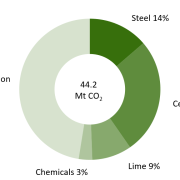New German climate goal only possible with negative emissions?
Following the ruling of the Federal Constitutional Court in April 2021, the German government had to revise the Climate Protection Act. According to the revised law, Germany must be climate neutral as early as 2045 and greenhouse gas negative by 2050. These higher climate ambitions also mean earlier use of significant amounts of negative emissions. What changes have there been in climate legislation and what do the latest scenarios on carbon removal say for Germany?
As promised in our article on the global dimensions for negative emissions, this time around, we want to have a closer look at Germany. The country is touted for being one of the leaders in decarbonizing the energy system of an industrialised country both in terms of speed and scope. Renewable energies already make up 45 to 50 per cent of Germany’s electricity consumption with a goal to reach 65 per cent in 2030.
Updated climate target requires climate neutrality by 2045
The German climate law has been revised in June 2021, after the Federal Constitutional Court required changes and more ambitious action. As a result the current government updated the country’s climate goals with an increased ambition towards climate or greenhouse gas neutrality by 2045. From 2050 onwards Germany is supposed to be greenhouse gas negative. Figure 1 depicts Germany’s historical emissions, the targets stipulated in the new law and potential negative emissions in 2050 according to the study Klimaneutrales Deutschland 2045 (Climate neutral Germany 2045) (data sources: BMU, UBA, Agora Energiewende).
For 2021, Agora Energiewende expects the strongest annual increase in emissions since 1990, with a plus of almost 50 Mt (source: Agora Energiewende). This means that emissions this year could be back at the level of 2019 before Corona. The emission reduction of 40 per cent compared to 1990, which the country managed to achieve in 2020, would then be obsolete again.
Are negative emissions part of the German climate strategy?
A few years ago negative emissions or CCS were not part of the discussion concerning the climate and emissions reduction strategy in Germany, at least not on the policy level and only partially in the scientific context. This outlook changed:
- It is increasingly clear that emissions of greenhouse gases will remain in hard-to-abate sectors (such as industry and agriculture) even after strong emission reductions.
- The current efforts of decarbonizing sectors other than the electricity sector, specifically buildings and transport is lagging behind and might not deliver the emissions reductions needed to even achieve the older and less ambitious climate targets.
- Climate ambitions grew as the impact of a warming planet is already clearly visible and civil society demands more action. On the EU level the new target of 55 per cent emission reductions by 2030 compared to 1990 has been agreed on, and Germany followed suite with its new climate law.
Therefore negative emissions are more prominent in recent scenarios and studies on how Germany might be able to achieve its climate targets. On the policy level, they are only implicitly mentioned in the new climate law in terms of negative emissions in the Land Use, Land-Use Change and Forestry (LULUCF) sector. Concrete expansion targets for technologies that generate negative emissions are still lacking.
How much negative emissions does Germany need?
In this analysis we present and compare the results and implications of three detailed studies released during the past three months: the study Klimaneutrales Deutschland 2045 (Climate neutral Germany 2045) by Agora Energiewende, the outcomes of the Fraunhofer ISI project Langfristszenarien für die Transformation des Energiesystems in Deutschland (Long-term scenarios for the transformation of the energy system in Germany) commissioned by the German Ministry for Economic Affairs and the working paper Wissensstand zu CO2-Entnahmen (Knowledge base on CO2-removals) by the Mercator Research Institute on Global Commons and Climate Change (MCC).
Based on those three publications, figure 2 depicts the projected needs for negative emissions in Germany. All of the studies agree that negative emissions in the order of several ten to hundred millions of tons CO2eq will be needed in Germany by 2050 to achieve the country’s climate targets.
According to current estimates Germany emitted about 740 Mt of greenhouse gases in 2020. As figure 2 shows, the negative emissions necessary by the time Germany wants to reach climate neutrality (2045) range from 67 to 100 Mt CO2eq, so 9 to 13 per cent of 2020’s emissions. Scaling-up nature-based and technological solutions and technologies is already required starting today and in this decade. At present, the use of technologies to remove CO2 from the atmosphere is comparatively expensive. Reducing these costs requires massive investments in technical and organisational infrastructure, and comprehensive political and economic support.
To some extent the new German climate law takes into account negative emissions and aims at a contribution of LULUCF sector of 25, 35 and 40 Mt in 2030, 2040 and 2045, respectively. However, land-use and forestry related carbon removal suffer from low permanence, tricky accounting and potential reversibility through misaligned management practices or natural events such as wildfires.
Thus, in addition to negative emission from the LULUCF sector as part of nature-based carbon removal solutions, technological removals will be needed as well according to all of the three studies. In a coming article we will dive deeper into the proposed kinds of negative emissions solutions for achieving Germany’s climate targets and the potential of some of those solutions.
To learn more about carbon removal and how it can play a role for your company’s climate strategy, follow us on Twitter or LinkedIn, subscribe to our newsletter or directly get in touch with us.








Leave a Reply
Want to join the discussion?Feel free to contribute!